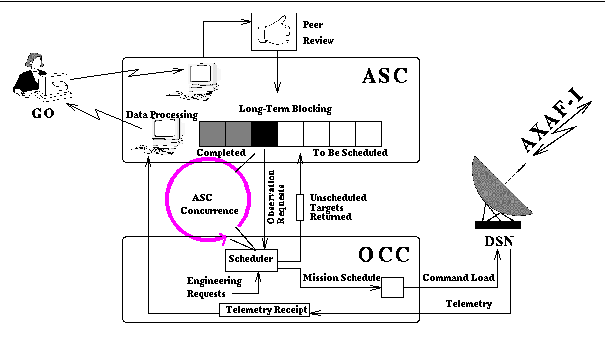AXAF-I will be placed into a high elliptical orbit (see
The AXAF Orbits). The nominal orbit, with
a perigee of 16,378 km and
an apogee of 106,378 km, has a period of 42.1 hrs and will provide
large amounts of time () above the high radiation regions.
This means that the mission will be capable of carrying out
uninterrupted observations for durations exceeding 100 ks. In the
likely new orbit the percentage of time above the high radiation
region increases to
. While below the radiation cut-off
altitude (nominally at a geocentric distance of
km),
some engineering and calibration activities will still be possible, as
will slewing operations, but science observations will cease. With
solar panels capable of rotating about one axis, the majority of the
sky (minus avoidance regions around the sun, bright Earth, and bright
moon) can be observed at any time of the year. The resulting ability
to schedule science observations efficiently, with minimal
interruption (unless explicitly requested), will help maximize the
scientific output of the mission.
Following launch, an initial period of spacecraft and instrument
checkout activities will ensue. These activities, expected to last
month, will be followed by a period of investigations carried
out by Guaranteed Time Observers (GTOs). These observers include the
Science Instrument Principal Investigators, the Telescope Scientist,
and several Interdisciplinary Scientists. The details of GTO time are
currently being formalized (see ``Report from the Project Scientist''
and ``AXAF Users' Committee Report'' in this Newsletter), but it is
anticipated that the associated observations will span 100% of the
first two months of science observations, followed by a smaller
fraction for some number of years into the mission.

Figure 11. The flow of target information from proposal to publication
Targets approved as part of the General Observer (GO) program will begin being scheduled for the third month of observations. This GO program will be initiated by a NASA Research Announcement (NRA) approximately one year prior to launch. The frequency of NRAs has not yet been decided and depends on details concerning the GTO time, but it is probable that NRA-1 will span the first 6 months of GO time, with subsequent NRAs being announced at roughly 12 month intervals.
Proposals submitted through the GO process will be evaluated by a NASA
Peer Review. The ASC will then fit targets approved for observation
into a long-term schedule of week blocks. This long-term
schedule will lay out time slots during which particular
instrument/gratings configurations are utilized. Each week, an
oversubscribed list of observations, occasionally including
calibrations, will be sent to the AXAF Operations Control Center (OCC)
at MSFC for creation of a detailed Mission Schedule. All observations
accepted in the peer review process are expected to be carried out;
oversubscription of targets for efficient generation of the Mission
Schedule will be achieved by oversubscribing the weekly lists and then
soliciting new GOs early enough to use the new targets to pad the end
of the current NRA period. It is thus not anticipated that a
`Category C' class of targets, whose observing time or status is in
question, will be created. Targets from the oversubscribed weekly
lists which do not make it into the Mission Schedule will be
re-entered into subsequent lists generated by the ASC, with a priority
towards inserting them into the weeks immediately following initial
placement in the long-term schedule. The procedure is summarized in
Figure 11.
Following ASC concurrence of the Mission Schedule, the OCC will create
a detailed operations timeline which contains the time-ordered
sequences required to carry out the planned observations. This
timeline will include details of instrument configuration, telemetry
links, slews and target acquisitions, etc. The timeline will then be
converted into command loads which are sent to the spacecraft.
Contacts are carried out via the Deep Space Network (DSN)
approximately three times each day, with uploads made typically once
per day. Commands for 72 hours of operations are sent to the
spacecraft, however, to ensure continued operation even in the event
of missing several telemetry passes. Omnidirectional antennae on the
spacecraft provide the capability of data dump and receipt without
interruption of observations. DSN contacts typically last minutes; data are returned at a telemetry rate of 512 kilobits per
second.
Data will be received at the ASC within hours of the
observations. The data will be processed in a pipeline operation to
produce FITS files and other data products for the users.
Simultaneously, the telemetry and standard data products will be
monitored by ASC staff to detect changes in instrument performance.
Tallies of the good on-target time for each observation will be
compared with the requested time, with deficits forwarded to the
mission planning process for reintroduction of the target into an
ensuing timeline. It is expected that data products will be sent to
the users within one week of the completed observation. In accordance
with NASA policy, observers maintain proprietary data rights for a
period of one year, after which the data are entered into the public
archive.
----------------